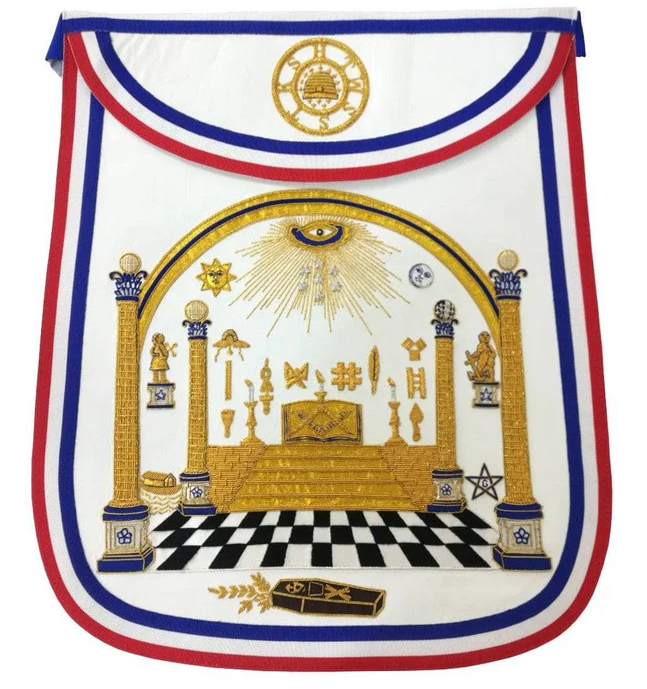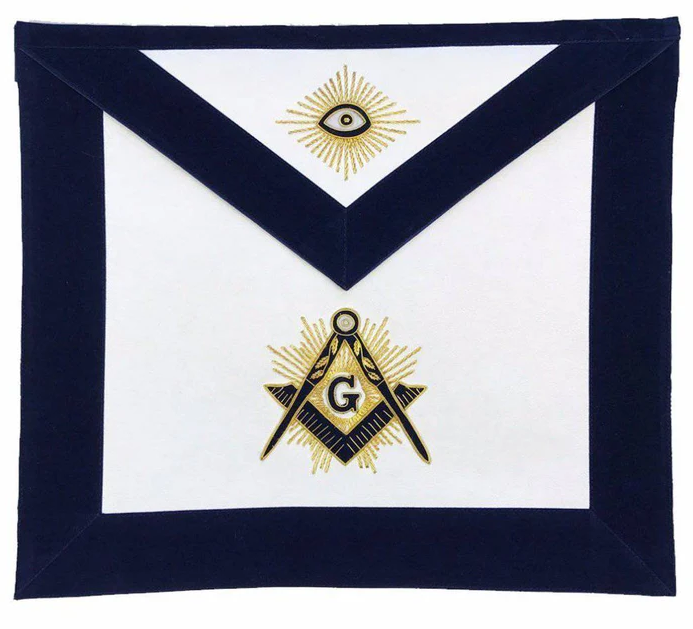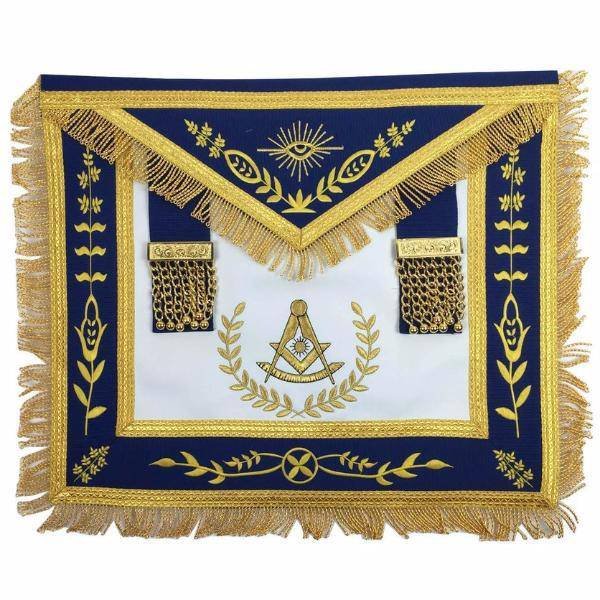
What Is a Masonic Apron? Understanding the Symbolism
The Masonic apron is a key symbol in Freemasonry. It means a lot to its members. But what does it really stand for?
It’s not just a piece of clothing. It shows honor, purity, and the start of a Mason’s journey. Each apron has its own story, from the simple white lambskin to the fancy designs of higher degrees.

Over time, the apron’s design has changed. Today, it has detailed symbols and colors. These symbols mean different things. For Freemasons, their apron is very special. It connects them to the craft’s history and traditions.
Key Takeaways
- Masonic aprons symbolize honor, purity, and initiation in Freemasonry
- The design of the apron changes as a Mason progresses through degrees
- White lambskin is used for the Entered Apprentice apron, signifying innocence
- Aprons feature symbols like rosettes and tassels, each with unique meanings
- The Masonic apron is considered a sacred and personal item for Freemasons
The Historical Origins of Masonic Aprons
Masonic aprons have a long history of over 300 years. They started in the early 1700s as clothes for stonemasons. Now, they are special symbols in Freemasonry. The Scottish Rite Masonic Museum & Library has many of these aprons, showing their importance.
You may also like: What Happens In A Masonic Temple? 10 Surprising Facts For The Haters
From Operative to Speculative Masonry
Long ago, stonemasons wore big aprons made of animal hide. These aprons protected them from sharp rocks. As masonic traditions changed, these aprons became symbols.
By 1717, more people were joining as “Accepted” Masons. This change made aprons more symbolic and decorative.
Evolution Through Medieval Trade Guilds
Medieval trade guilds helped shape Masonic customs. In the late 1600s, non-stonemasons started joining. This brought new designs to the aprons, mixing use and meaning.
Transition After the 1717 Grand Lodge Formation
The first Grand Lodge was formed in 1717. This changed apron designs and meanings. Between 1760 and 1770, aprons got smaller, showing the rise of speculative Masonry.
During this time, embroidery on aprons grew, thanks to new printing and engraving. By 1786, aprons were smaller and more decorated. The United Grand Lodge of England made aprons the same after 1814. By the 1840s, they were all the same, showing the lasting tradition of Freemasonry.
What Is a Masonic Apron
A Masonic apron is a key part of masonic regalia for Freemasons. It carries deep meaning and serves many roles.
Definition and Basic Components
The Masonic apron is a rectangular piece of fabric. It has rounded corners and is worn at the waist. It has a flap that hangs down over the thighs.
The design of the apron has stayed the same for over 300 years. This shows its big role in Freemasonry.
Materials and Construction
Masonic aprons are usually made from white lambskin. This material stands for purity and innocence. For those who don’t eat meat or animal products, there are other materials now.
The size of the apron can vary. Most are between 14 to 25 inches long and wide.
Primary Functions in Freemasonry
The Masonic apron is a symbol of honor and moral purity. It’s key in rituals and shows a Freemason’s growth. Each apron tells a story of a Mason’s journey.
“The apron is the badge of honourable labour within our organization.”
The Sacred Symbolism of Lambskin
The lambskin apron is very important in Freemasonry. It stands for purity and innocence. This simple apron holds deep meaning for Masons all over the world.
Significance of White Color
The white color of the apron means moral purity. It tells Masons to live upright. The color is like snow, showing its link to cleanliness and goodness.
Also see: The Masonic Bible – Here Are At Least 10 Surprising Facts The Haters Don’t Know
Purity and Innocence Representation
In Masonic teachings, the lamb means innocence. This idea goes back a long time. The First Degree of Masonry uses the lamb to show purity.
Masons are told to keep their aprons clean. This shows their moral character.
Traditional Material Choice
Lambskin has been used for Masonic aprons for centuries. It comes from biblical times, where lambs were symbols of sacrifice and purity. The apron reminds Masons to live honorably.
The lambskin apron is more valuable than symbols like the Golden Fleece or the Roman Eagle. It shows the highest values in Freemasonry. Wearing this apron means promising to live by these values all your life.
Progression Through Masonic Degrees
The Masonic apron changes as members move up in rank. This change shows a Mason’s growth in knowledge and duty. In Scottish Lodges, the apron is given at each degree, with a 100% rate for new members.
Entered Apprentices get a plain white apron. It stands for innocence and purity. This simple apron matches the first degree’s basics. As Masons move up, their aprons change to show their progress.
Fellow Crafts see small changes in their aprons. These changes show they’ve moved from being just a “hand” to an “intelligent head and hand.” This change highlights the importance of learning in Masonic rituals. The apron now has turned-up corners, showing the Mason’s growing understanding.
Master Masons wear aprons with detailed designs. These designs show their advanced knowledge and status in the lodge. The apron includes symbols like the square and compass, standing for morality and self-control.
“The Masonic apron serves as a visual chronicle of a member’s journey, reinforcing the importance of continuous learning and personal growth.”
This journey through degrees, shown in the apron changes, shows Freemasonry’s focus on lifelong learning and self-improvement. Each step in a Mason’s path is marked by these sacred symbols. They remind Masons of their duties and achievements in the craft.
Distinctive Features and Decorative Elements
Masonic aprons are full of special designs. These designs tell stories of growth and values in the masonic craft.
Rosettes and Their Meaning
Rosettes are very important in Masonic aprons. The Fellow Craft apron has two blue rosettes at the bottom. The Master Mason apron adds a third on the flap.
These rosettes started in England in 1815. They show different levels of Masonic growth.
Colors and Their Symbolism
Colors on Masonic aprons mean a lot. White represents purity and innocence. Blue lining and edging show fidelity and friendship.
Tassels and Metal Elements
Tassels and metal parts make Masonic aprons fancy. They often have symbols like the square and compass. These symbols show the masonic craft’s rich traditions.
Apron decoration has changed over time. It went from hand painting to embroidery and engraving. Each change shows the evolution of freemasonry’s art.
The George Washington Masonic Apron Legacy
The George Washington Masonic Apron is a key part of Freemasonry’s history in America. It was given to Washington in 1784. It shows how Masonic symbols and designs have changed over time.
Historical Significance
George Washington joined Freemasonry at 20. He paid two pounds and three shillings to join the Lodge at Fredericksburg, Virginia. He became a Master Mason on August 4, 1753.
The Lafayette Apron was given to Washington in 1784. It symbolizes his Masonic legacy.

Design Elements and Symbolism
The apron’s design is full of symbols. It has red, white, and blue colors. These colors mean courage, purity, and fidelity.
It has symbols like Rays of Glory and Adamic Pillars of Enoch. A five-pointed star shows the Five Points of Fellowship. The apron also has twelve unique Masonic images and represents the Four Cardinal Virtues through its tassel.
Impact on Modern Apron Designs
Washington’s apron has influenced modern Masonic apron designs. Its symbols and history inspire today’s Masonic regalia. The apron was given to the Grand Lodge of Pennsylvania in 1829.
This made it a big part of Masonic lore. It helped shape the fraternity’s identity in the United States.
Different Types of Masonic Aprons
Masonic attire changes with each Masonic group. The Scottish Rite, York Rite, and Shriners have their own apron designs. These aprons show a Mason’s rank and achievements.
The Master Mason apron is 14 inches by 16 inches. It’s made of lambskin and is white with blue thread. Some choose synthetic leather aprons to keep the white look.
Lodge officers and Grand Lodge members have special aprons. These aprons show their rank and duties. They might have rosettes, ribbons, and tassels.
The Fellow Craft apron has two sky-blue rosettes. The Master Mason apron has three rosettes, a sky-blue ribbon, and seven tassels on each ribbon.
Masonic apron designs have changed over time. In the 18th century, they were hand-painted. By the 19th century, engraved aprons became popular. Today, Masonic aprons are still important symbols of a Mason’s journey.
Care and Preservation of Masonic Aprons
Masonic aprons are very special. They often stay in families for a long time. It’s important to take good care of them.
Storage Guidelines
Keep your apron in a cool, dry spot. Don’t let it get too much sunlight. It can make the colors fade.
Use a soft hanger to keep it smooth. You can also put it in a bag that lets air through.
Cleaning and Maintenance
Be gentle when you clean your apron. If it’s made of lambskin, just use a soft, wet cloth. For synthetic ones, a little soap is okay.
Always test a small area first. This makes sure you won’t damage it. Dust it often to keep it looking good.

Preservation Techniques
Always wear clean hands when handling your apron. Don’t fold it to avoid creases. For older aprons, getting help from a pro is a good idea.
“The Masonic apron holds more honor than any decoration conferred by kings.”
By following these tips, your apron will stay special for a long time. Taking care of it keeps its value and the tradition it stands for.
Also see: How Long Does It Take To Become A Freemason
Conclusion
The Masonic apron is key to Freemasonry symbols. It shows a Mason’s journey, moral duties, and growth. It also shows their wish to make the world better.
The apron started in real masonry but now is a symbol of pride. The white lambskin apron reminds new members of purity and equality. It shows that all Masons are equal, no matter their rank.
Masonic aprons look different, showing the Mason’s level and role. But their main goal is the same: to bring Masons together. They are worn in meetings, at funerals, or kept as a special keepsake. The apron connects Masons to their history and values.
FAQ
What is a Masonic apron?
A Masonic apron is a special cloth worn by Freemasons. It shows their commitment to being pure and honorable. It’s like a badge that shows their journey in the fraternity.
Why is lambskin used for Masonic aprons?
Lambskin aprons symbolize purity and innocence. The white color means being upright. But, vegans and vegetarians have other options now.
How do Masonic aprons change as members progress through degrees?
Aprons change as members get higher degrees. The Entered Apprentice has a simple white apron. The Fellow Craft apron has small changes. The Master Mason’s apron is more detailed, showing their growth.
What symbols are commonly found on Masonic aprons?
Aprons often have symbols like rosettes and the square and compass. Colors like blue and gold also have meanings. These symbols show the wearer’s rank in Freemasonry.
What is the significance of the George Washington Masonic Apron?
The George Washington Masonic Apron is very important. It shows early American Freemasonry’s design and symbols. It has influenced today’s aprons and is a symbol of Freemasonry’s history in the U.S.
Are there different types of Masonic aprons?
Yes, there are many types of Masonic aprons. Each has its own design. Lodge officers and Grand Lodge members also have special aprons that show their rank.
How should a Masonic apron be cared for and preserved?
Aprons need to be kept in a controlled environment. Use gentle cleaning methods. For older aprons, get professional help. This keeps them as valuable heirlooms.
Can non-Masons wear Masonic aprons?
Usually, aprons are for Masons only. They are sacred and worn during Masonic events.
How has the design of Masonic aprons evolved over time?
Aprons started as practical clothes for stonemasons. The first Grand Lodge in 1717 changed their meaning. Now, they are more detailed and follow certain rules.












